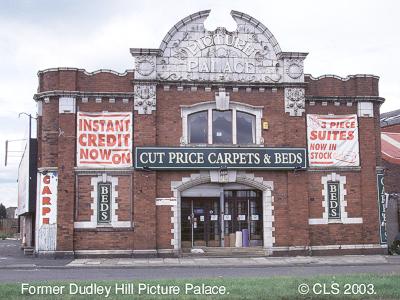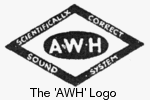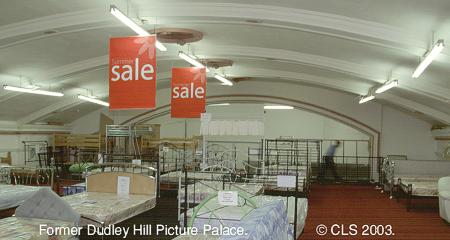|
Dudley Hill Picture Palace Tong Street, Bradford.
 Location Walter Goodall (1868-1933) and his brother Percy followed this success with their new venture at Dudley Hill in a prime position on the west side of Tong Street between Compton Street and Factory Street and near a busy crossroads (now the outer Ring road) and then in a heavily built-up area densely populated with potential customers. The Building The stylish frontage was topped by a central pinnacle (now removed) and the name 'Picture Palace'; whilst above the front entrance is the erection date of 1912. The Interior The stalls seating of almost 600 was arranged in two blocks with centre and side aisles with the front row 14ft 6inches from the screen. At its opening the first six rows at the front were forms. The straight fronted circle was unusual in that the projection room was in the middle thus dividing the circle into two parts with five rows of seats each side of projection room - a total of just 88 seats. Opening "How's Your Father?" - USA 1912 B/W SilentIncidental music was provided by a piano and later a small orchestra. In the early days with A. Crossland as manager, it was two shows nightly with two programme changes each week. By 1926 with A. Ellis as manager, the Picture Palace had changed to once nightly on weekdays and three shows on Saturdays with prices from 4d to 11d. Sound Arrives 
It was the AWH sound system named after its electrical engineer inventor, Arthur William Harris (AWH = 'Always Worth Hearing') and eventually installed in over 200 independent cinemas and air force/naval camp cinemas together with the projection rooms of the British Board of Film Censors. Its main claim was quality of both speech and music together with reliability and minimal maintenance. Its full title was 'The AWH Talking Picture Reproducing Apparatus' and could be bought outright rather than leased as with BTH, RCA and Western Electric sound systems. The first full length talkie film was shown on Monday 27th October 1930 was . . . "Such Men are Dangerous" - 1930 USA B/WThe company was later known as Goodall's Pictures (1931) Ltd and the seating capacity was listed as 600. Later (date unknown) the Western Electric set was installed and remained, with upgrades, until closure. Later Years Percy Goodall's son-in-law A.D Thornton ran the Dudley Hill Picture Palace as its resident manager and in 1963 shortly after the cinema had celebrated its 50th anniversary he was quoted in the local newspaper as saying "The cinema was the first in Bradford to have thermostatically controlled central heating on the new oil fired system". Prices in 1963 were 9d to 2/-. Closure "Thunderbirds are Go" - UK 1966 Technicolor 93 mins Bingo then Carpets Eventually the premises now owned by a Mr Hodgson opened its doors once more to the public but this time leased out as a carpet and now plus a bed showroom trading as 'Cut Price Carpets' and is still operating in 2004. The balcony level has been extended the full length of the former auditorium and into the proscenium area so creating a full new floor for bed displays. The original ceiling and proscenium arch are still evident as is the original raked floor for the former stalls.  Despite these two diverse occupancies, the Picture Palace building remains virtually unaltered and is a time capsule of a 1912 vintage picture house and the present occupant tells me that they are quite accustomed to cinema enthusiasts visiting to look around and photograph the building. May not be copied or reproduced without permission.
|